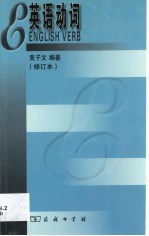图书介绍
英语动词pdf电子书版本下载

- 黄子文编著 著
- 出版社: 北京:商务印书馆
- ISBN:7100033780
- 出版时间:2002
- 标注页数:256页
- 文件大小:4MB
- 文件页数:273页
- 主题词:
PDF下载
下载说明
英语动词PDF格式电子书版下载
下载的文件为RAR压缩包。需要使用解压软件进行解压得到PDF格式图书。建议使用BT下载工具Free Download Manager进行下载,简称FDM(免费,没有广告,支持多平台)。本站资源全部打包为BT种子。所以需要使用专业的BT下载软件进行下载。如 BitComet qBittorrent uTorrent等BT下载工具。迅雷目前由于本站不是热门资源。不推荐使用!后期资源热门了。安装了迅雷也可以迅雷进行下载!
(文件页数 要大于 标注页数,上中下等多册电子书除外)
注意:本站所有压缩包均有解压码: 点击下载压缩包解压工具
图书目录
Chapter Ⅰ Five Types of the English Verb 7
Ⅰ.The Intransitive Type 8
Ⅱ.The Linking Verb Type(Various Predicatives) 9
Ⅲ.The Mono-transitive Type (Various Objects) 13
Ⅳ.The Di-transitive Type 17
(a)Convertible into Mono-transitive with“to” 18
(b)Convertible into Mono-transitive with“for” 19
(c)Not very well Convertible into Mono-transitive 19
Ⅴ.The Complex Transitive Type 20
(a)With a Noun or Noun-equivalent Complement 21
(b)Whit an Adjective or Adjective-equivalent Complement 22
(1)to show result 22
(2)to show state 23
(3)a past participle to show pas-sive meaning 24
(c)With a Verbal Complement to Indicate Action 24
(1)the infinitive with“to” 24
(2)the infinitive without“to” 25
(3)the present participle 26
(4)either the present participle or bare infinitive without appreciable difference of meaning 27
(5)either the present participle or infinitive with clear distinc-tion of meaning 28
(6)the infinitive“to be” 29
(7)the preparatory“it”and com-plement 31
ChapterⅡ Tense 33
Ⅰ.Basic Use or Meaning of Each of the Tenses 37
Ⅱ.Extended Use or Uses of the More Common Tense Forms 45
A.The Simple Present Tense 45
B.the Present Progressive Tense 51
C.The Present Perfect Tense 52
D.The Present Perfect Progressive Tense 54
E.The Past Tense Forms 55
F.The Simple Future Tense 57
G.The Future Progressive Tense 57
H.The Future Perfect Tense 58
I.The Past Simple Future Tense with“Would” 58
J.The Past Future Perfect Tense 59
Ⅲ.Time and Tense 59
A.Denotation of Present Time 59
B.Denotation of Habitual,Permanent or Repeated Action 60
C.Denotation of Past Time 61
D.Denotation of Future Time 62
E.Denotation of Duration of an Action or of Absence of an Action Beginning in the Past and Continuing to the Present(Possibly to the Future) 64
Ⅳ.Comparison Between Some of the Common Tenses 65
Chapter Ⅲ Special or Anomalous Verbs 68
Ⅰ.What Special Verbs Are 68
A.Ability to Form the Tag Question 71
B.Ability to Form Short Answers 72
C.Ability to Form Elliptical Sentences 75
E.A Mid-position Adverb to Follow Rather than Precede the Special 76
D.Ability to Form an Emphatic Affirmative 76
F.With Most Specials,No Inflexion for the Third Person Singular of the Present Tense 77
Ⅱ.Special or Non-special? 78
A.“Need” 78
B.“Dare” 79
C.“Used to” 80
D.“Have”and“have to” 81
E.“Do” 84
Ⅲ.Mood,Emotion and Attitude 84
A.Requests,Commands,Prohibitions,Invitations and ,Suggestions 85
B.Promises,Threats and Refusals 86
C.Wishes and Preferences 87
D.Plans and Arrangements or Decisions 88
E.Obligation and Necessity 89
F.Permission 89
G.Probability and Likelihood 90
H.Possibility 92
I.Ability and Achievement 95
J.Determination and Resolve;Willingness 97
K.Concession 99
L.Surprise 100
M.Characteristic Behaviour 100
Ⅳ.Semi-modal Verbs 101
Chapter Ⅳ Voice 104
A.Examples Showing Transitive or Prepositional Verbs Which as a Rule Do not Occur in the Passive 118
B.Examples Showing the Inconvertibli-ty of an Idiom and Active Transitive Verb Has Entered into 118
C.Examples Showing Those Transitive Verbs Which Are Mostly,or Can Often Be,Used in the Passive 120
D.Verbs,Active in Form but Passive in Meaning 123
(A)Intransitive and Linking Verbs 123
(a)Finite Verbs 124
(B)Transitive Verbs 124
(b)Non-finite Verbs 125
(1)A Transitive Gerund 125
(2)A Transitive or Prepositional-Verb Infinitive 125
Chapter Ⅴ Mood 127
Ⅰ.The Imperative Mood 128
Ⅱ.The Subjunctive Mood 130
A.General 130
B.The Subjunctive Present Tense 134
C.Meaning of Subjunctive Mood 137
(A)The Pure Subjunctive 138
(B)The Half Subjunctive 141
(C)The Old-styled Subjunctive Present Tense 144
(D)The False Subjunctive 145
D.Subjunctive or Indicative? 147
E.Conditions Expressed by Inversion 153
F.Conclusion 154
Chapter Ⅵ The Non-finites 155
Ⅰ.The Finite Verb versus the Non-finite 155
Ⅱ.Agent of the Non-finite 159
Ⅲ.Contrasts Between the Non-finite 163
A.As Subject 163
B.As Predicative 164
C.As Object 168
(A)of a Transitive Verb 168
(B)of a Preposition 170
D.As Attributive 170
(A)Transitive Present Participle versus Transitive Past Participle 170
(B)Intransitive Present Participle versus Intransitive Past Participle as Premodifier 171
(C)Present Participle versus Gerund as Premodifier 173
(D)Present Participle versus Infinitive 175
(E)Infinitive versus Gerund or Preposition plus Gerund 178
E.As Adverbial 179
(A)The Participle and the Infinitive 179
(B)“Go”plus Infinitive ersus 183
F.No-finites as Object Complements 185
G.Non-finites as Independent Elements(Disjuncts) 187
Ⅳ.Voice of the Non-finites 189
Ⅴ.The Tense Forms of the Non-finites 191
B.of the Complement Infinitive 192
A.of the Predicative Infinitive 192
C.of the Adverbial Participle 193
Ⅵ.The Adverbial Non-finite and the Adverbial Clause 195
Ⅶ.The Non-finite Postmodifier and the Adverbial Clause 201
A.The Present Participial Phrase 201
B.The Past Participial Phrase 202
C.The Infinitive Phrase 204
Ⅷ.The Split Infinitive 205
A.As Complement to the following Verbs 207
Ⅸ.The Bare Infinitive 207
B.As Predicative 209
C.After Modal Verbs 210
D.After Certain Prepositions 210
Ⅹ.The Elliptical Infinitive 211
Ⅺ.The Half Gerund 212
Ⅻ.Verbal Construction after“Rather than”and“As well as” 216
Chapter Ⅶ Verbs and Their Prepositions 219
A.Intransitive Verbs followed by Prepositions 223
(A)Omission of Preposition from Prepositional Verb Governing “that”Clause 223
(B)Cases Where Omission of Preposition Produces No difference in Meaning 225
(C)Cases Where Omission of Preposition Will Produce a Difference in Meaning 226
(D)Cases Where a Different Preposiition Gives a Difference Meaning to Verb 232
(E)Cases Where a different Preposition Gives No Apprecialbe Difference Meaning to Verb 238
(F)Intransitive Verbs with Double Prepositional Phrases 240
B.Transitive Verbs Followed by Prepositions 240
(A)Mono-transitive Preposition Combinations Which Admit of Object Shuffling 242
(B)Mono-transitive Preposition Combinations Which Are Liable to Abuses of Object Shuffling 243
(C)Cases Where a Different Preposition Gives a Different Meaning to the Situation 243
(a)With Verbs in the Active Voice 244
(D)A Few Cases Where Mono-transitive Preposition Combinations May Become Other Mono-transitive or Di-transitive Constructions by Dropping the Preposition 247
(E)Great Majority of Mono-transitive Preposition Constructions Are Fixed and Invariable 248
(F)A Few Reflexive Mono-transitive Preposition Constructions ,Which Are Fixed and Invariable 249
C.The Verb“to be”Followed by Prepositions 249
(A)“TO BE AT”with Phrases 250
(B)“TO BE IN”with Phrases 251
(C)“TO BE ON”with Phrases 252
(D)“TO BE OUT OF”with Phrases 253
(E)Miscellaneous “TO BE plus Preposition”Phrases 253
D.Conclusion 256